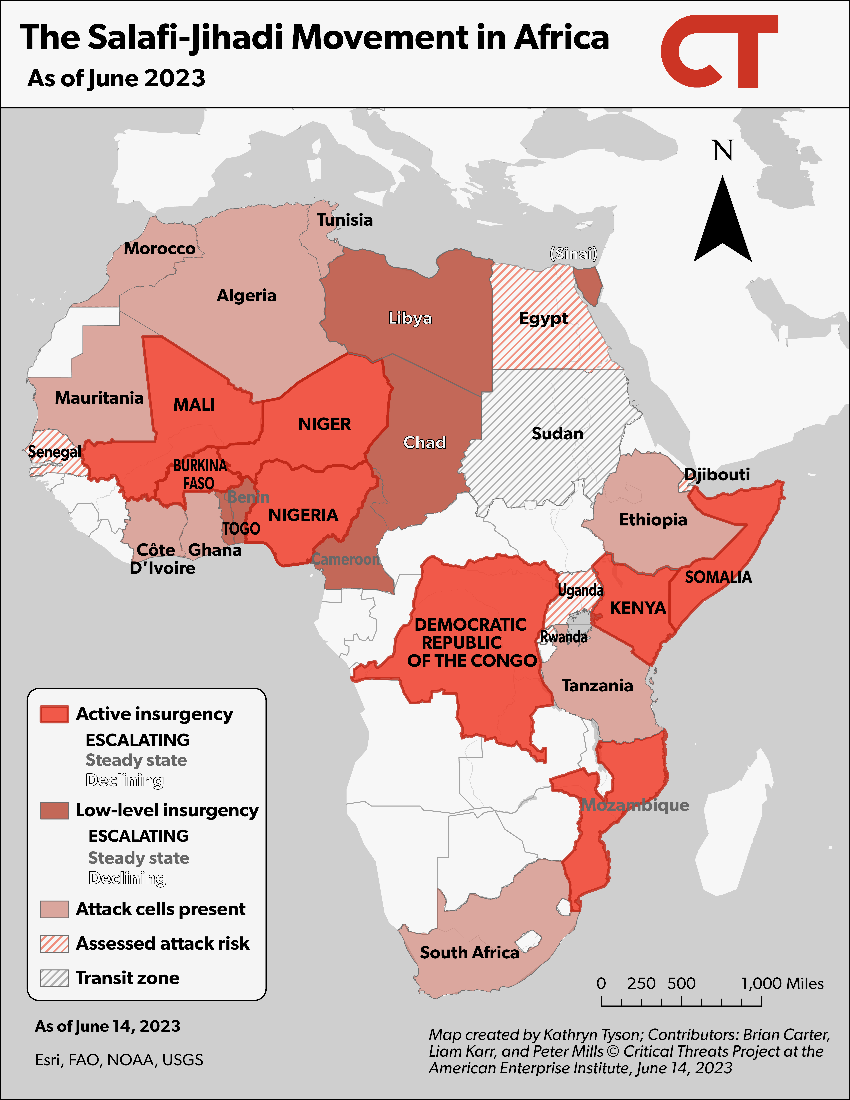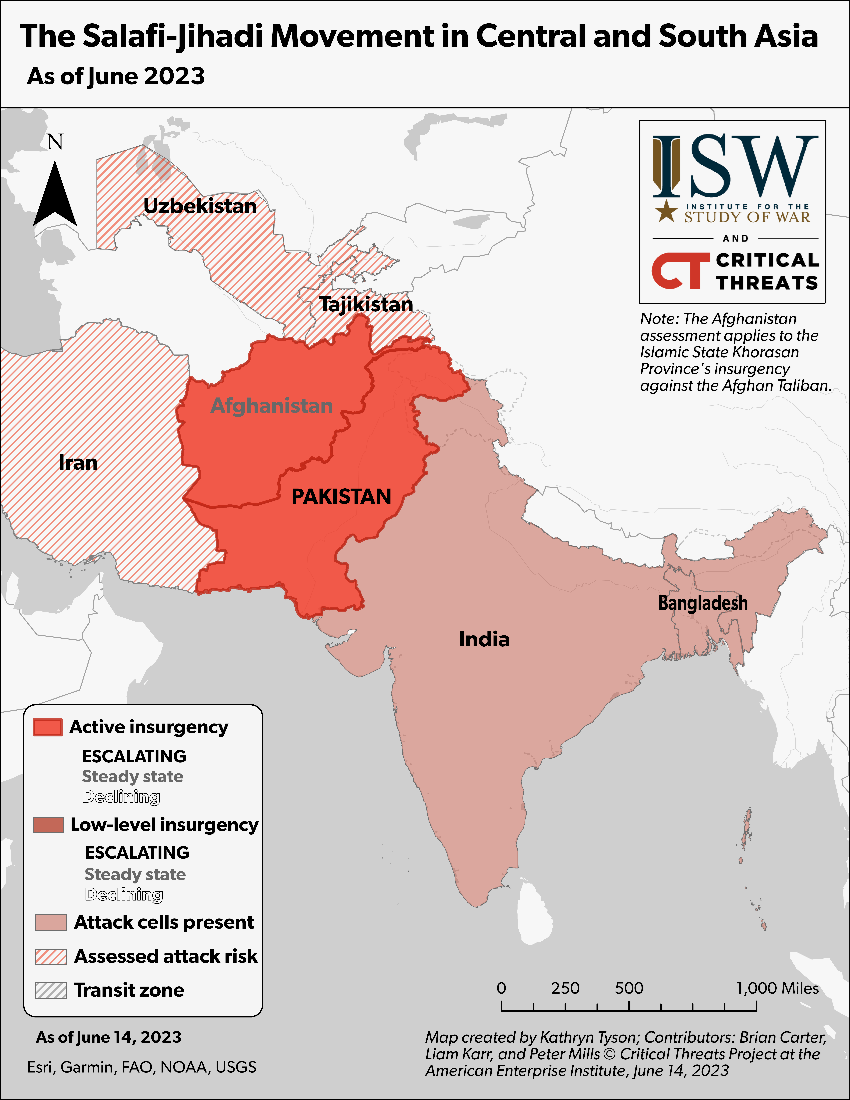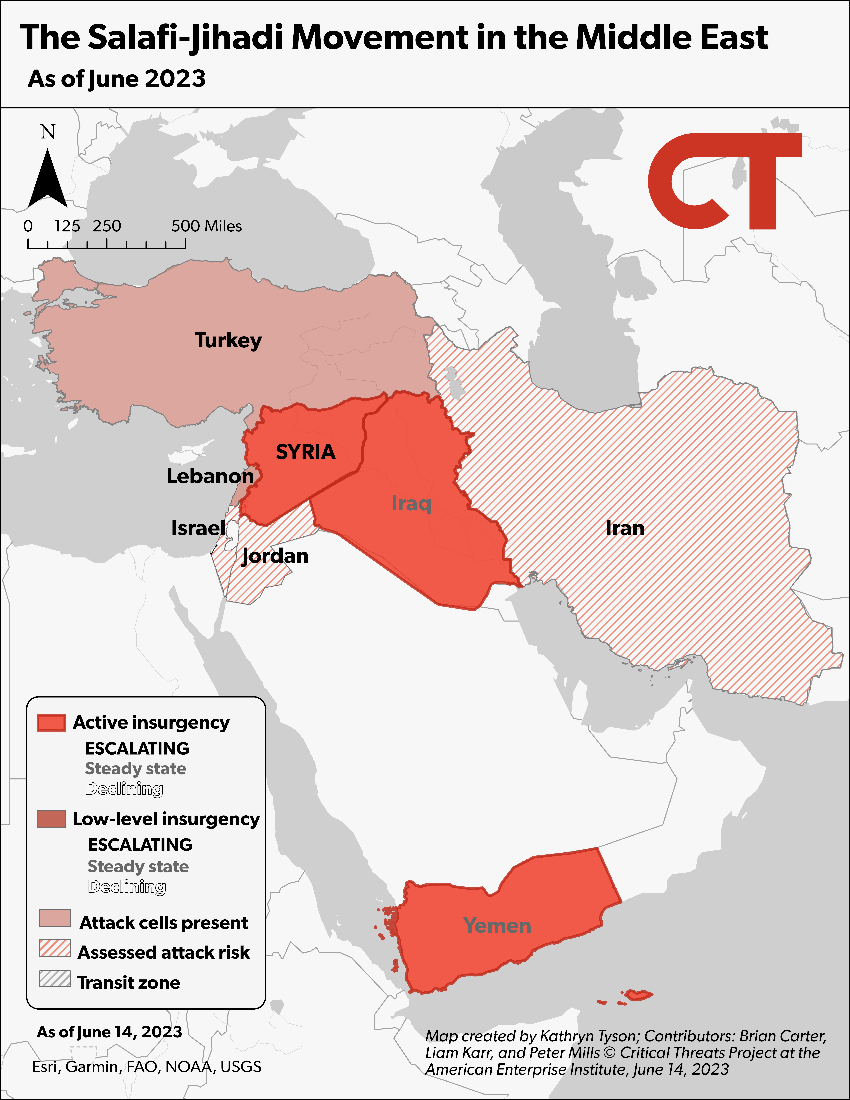 |
 |
Salafi-Jihadi Movement Weekly Update, June 15, 2023

Salafi-Jihadi Movement Weekly Update, June 15, 2023
Authors: Kathryn Tyson, Liam Karr, and Peter Mills
Data Cutoff: June 14, 2023, at 10 a.m.
Key Takeaways:
Iraq and Syria. The Iraq and Syria section is on pause until the Salafi-Jihadi Movement Weekly Update, June 21, 2023.
Somalia. The Somali Federal Government (SFG) has to date failed to launch an offensive against al Shabaab in southern Somalia in 2023, which is likely enabling al Shabaab to increase the rate and severity of its attacks in Mogadishu. The group conducted its first suicide attack in Mogadishu in four months on June 9 and has increased car bomb attacks in Mogadishu since late May. The withdrawal of thousands of African Union soldiers by the end of June will likely create more security gaps for al Shabaab to exploit across the country in the coming months and will strain the Somali National Army’s (SNA) capacity as counterterrorism operations in central and southern Somalia remain stalled.
Afghanistan-Pakistan. Pakistani sources and pro-Taliban online accounts may have misreported that the Taliban killed the leader of the Islamic State Khorasan Province (ISKP) on June 9. Sanuallah Ghafari’s death would degrade ISKP attack coordination for several weeks or months as ISKP works to replace its leader and could also disrupt ISKP recruitment. The killing would not address ISKP supporters in the Taliban government or Taliban atrocities against civilians, which drive recruitment. Taliban infighting is hindering its counter-ISKP fight while ISKP is establishing new training camps in Afghanistan.
Assessments:
Somalia. The SFG has failed to launch an offensive against al Shabaab in southern Somalia in 2023, which is likely enabling al Shabaab to increase attacks in Mogadishu.[1] CTP previously assessed in May that al Shabaab had been giving priority to stalling a potential counterterrorism offensive in southern Somalia since early 2023, which contributed to a lull in large-scale attacks in Mogadishu since February.[2] Somali leaders have to date failed to build a coalition for such an offensive, including replicating the clan militia strategy the SFG used in central Somalia and requesting troops from neighboring countries.[3] Al Shabaab has increased the rate and severity of its attacks in Mogadishu since mid-May, showing it has refocused its efforts on Mogadishu. The group conducted its first suicide attack in Mogadishu since February on June 9.[4] Somali media reported that at least 15 people died in the attack, while Somali police and al Shabaab claimed that nine and 29 people died, respectively.[5] Al Shabaab has also conducted three car-bomb assassinations targeting Somali security forces in Mogadishu since May 17 after only conducting one in the rest of 2023.[6]
African Union Drawdown. The withdrawal of thousands of African Union soldiers by the end of June will likely create security vacuums for al Shabaab to exploit in the coming months. The African Union Transitional Mission in Somalia (ATMIS) is transferring some forward operating bases (FOBs) to Somali forces, collapsing others, and withdrawing 2,000 of the mission’s 22,000 total soldiers as part of a preplanned drawdown between June 15 and 30.[7] It is unclear which FOBs ATMIS will transfer or collapse. The drawdown is part of the Somali Transition Plan, which outlines the phased withdrawal of all ATMIS forces by the end of 2024.[8] Thousands of new Eritrean- and Ugandan-trained soldiers have returned to Somalia in the first half of 2023 to improve the SNA’s capacity as part of this planned transition.[9]
Assuming responsibility for ATMIS FOBs will likely strain the SNA’s capacity and divert SNA forces from stalled counterterrorism offensives in central and southern Somalia. Al Shabaab has halted the Somali offensive in central Somalia since early 2023 through a combination of large-scale attacks and undermining local support for the SFG in parts of central Somalia.[10] Additional troops are necessary for any resumed offensives in central or southern Somalia due to the lack of local clan militia support in the remaining al Shabaab–controlled areas.[11] The SFG has attempted to recruit assistance from neighboring countries to offset these capacity deficits in southern Somalia, but SNA troops will still be needed to give the offensive local legitimacy and hold any liberated territory after international forces withdraw.[12]
SNA forces will likely be less effective than ATMIS forces at projecting counterterrorism pressure because they lack adequate equipment. Most SNA units lack counter–improvised explosive device (IED) equipment and IED-resistant vehicles.[13] These shortages make SNA units static and unable to conduct patrols or secure transportation corridors.[14] Some SNA units also lack basic weapons. Thirty percent of SNA soldiers were unarmed, according to the most recent national readiness assessment in 2017.[15] It is unclear if training-partner countries are equipping these units with weapons and equipment as part of their agreements with the SFG.
Al Shabaab has already demonstrated that the newly trained SNA forces are vulnerable. Al Shabaab overran a base of the Eritrean-trained SNA forces in a recently liberated area of central Somalia on May 30, killing dozens of SNA soldiers.[16] The group also briefly overran the same base and killed local elders on April 22.[17] SNA forces will presumably take over ATMIS FOBs in less vulnerable areas than recently liberated frontline villages. However, SNA forces will face difficulties projecting counterterrorism pressure, which could allow al Shabaab to create havens it can use to launch similar large-scale attacks over time.
Al Shabaab has historically taken advantage of regional force withdrawals to fill resulting security vacuums. Al Shabaab took control of several towns in central and southwestern Somalia when Ethiopian forces abandoned several FOBs in 2016.[18] Al Shabaab still controls most of these towns, while Somali forces liberated others at a high cost as part of the central Somalia offensive.[19] The African Union, SFG, and UN have attempted to coordinate the June 2023 transfers.[20] However, the events of 2016 illustrate the most dangerous outcome if security forces withdraw from FOBs in vulnerable areas.[21]
Al Shabaab’s rhetoric indicates it will likely disproportionately target the Eritrean- and Ugandan-trained forces to undermine confidence in the new SNA units. Al Shabaab specifically framed the May 30 attack in central Somalia as an attack on the Eritrean-trained Somali forces.[22] Al Shabaab similarly framed the June 9 attack in Mogadishu as a challenge to the Ugandan-trained SNA units.[23] This rhetoric differs from the group’s statements on its previous suicide attacks in Mogadishu since September 2022 that framed the attacks as retaliations to the counterterrorism offensive in central Somalia.[24]
Figure 1. The Salafi-Jihadi Movement in Africa
Source: Kathryn Tyson.
Afghanistan-Pakistan. Pakistani sources and pro-Taliban online accounts may have misreported that the Taliban killed the leader of the ISKP. Pakistani media outlets and pro-Taliban accounts said that the Taliban killed ISKP leader Sanuallah Ghafari in Kunar Province in eastern Afghanistan on June 9.[25] Unspecified sources sent news of the killing to Pakistani news outlets, and unspecified Pakistani intelligence officials told Voice of America that the Taliban had killed Ghafari.[26] However, a Taliban spokesperson said the Taliban could not confirm the killing and is investigating the claim.[27] The United States has also not confirmed Ghafari’s death. The United States typically confirms senior Islamic State leader deaths.[28]
Ghafari’s death would degrade ISKP attack coordination for several weeks or months as ISKP works to replace its leader. The United States reported in February 2022 that Ghafari approves all operations in Afghanistan.[29] The killing could also disrupt ISKP recruitment. Ghafari has extensive social networks in Kabul, which bolstered ISKP recruitment in 2020.[30] Ghafari has also expanded ISKP ranks by recruiting more educated individuals and non-Salafists.[31]
Ghafari’s killing would not address the issue that ISKP has infiltrated the Taliban government and recruited from Taliban ranks, which allows ISKP to attack senior Taliban leaders. Ghafari’s death would also not stop Taliban atrocities against civilians or the Taliban’s targeting of Salafists that facilitates ISKP recruitment.[32]
Taliban Infighting Affects Counter-ISKP Effort. Taliban infighting could weaken the government’s ability to contain ISKP. The United Nations Security Council (UNSC) said in a June report that Akhundzada tried to fire the Afghan defense and interior ministers after they publicly criticized Akhundzada in February. Both leaders remain in their positions.[33] Akhundzada bolstered his personal security and reassigned a Taliban intelligence service special forces unit from fighting ISKP following the rhetorical clash.[34]
Akhundzada reassigned the unit at a time when ISKP is growing stronger in Afghanistan. The UNSC report said that ISKP built five new training camps in 2022 and maintains strongholds in northern and eastern Afghanistan.[35] CTP previously assessed that ISKP established new support networks in Badakhshan Province, northern Afghanistan, in 2023.[36] The report also assessed ISKP’s strength at 4,000–6,000 fighters, an increase from the 1,000–3,000 the UNSC assessed in February 2023.[37]
Figure 2. The Salafi-Jihadi Movement in Central and South Asia
Source: Kathryn Tyson.
Figure 3. The Salafi-Jihadi Movement in the Middle East
Source: Kathryn Tyson.
[1] https://www.criticalthreats.org/analysis/salafi-jihadi-movement-weekly-update-may-24-2023
[2] https://www.criticalthreats.org/analysis/salafi-jihadi-movement-weekly-update-may-10-2023
[3] https://www.voanews.com/a/somalia-s-neighbors-to-send-additional-troops-to-fight-al-shabab-/6986748.html; https://www.garoweonline dot com/en/news/somalia/somalia-jubaland-rejects-use-of-clan-militia-in-al-shabaab-war#:~:text=MOGADISHU%20%5BSMN%5D%20%2D%20Somalia's%20federal,of%20the%20operations%20was%20anchored; https://www.criticalthreats.org/analysis/salafi-jihadi-movement-weekly-update-may-24-2023#Somalia20230524
[4] https://www.criticalthreats.org/briefs/gulf-of-aden-security-review/gulf-of-aden-security-review-june-13-2023
[5] https://www.criticalthreats.org/briefs/gulf-of-aden-security-review/gulf-of-aden-security-review-june-13-2023
[6] https://www.longwarjournal.org/archives/2023/06/analysis-shabaab-takes-advantage-of-slowed-counter-offensive.php; author’s research.
[7] https://atmis-au.org/atmis-at-advance-stages-in-preparation-for-june-drawdown-of-2000-soldiers
[8] https://atmis-au.org/the-transition-process; https://atmis-au.org/atmis-mandate
[9] https://www.voanews.com/a/exclusive-somalia-sends-thousands-of-army-recruits-abroad-for-training-/6941868.html; https://twitter.com/GaroweOnline/status/1645568986539589634?s=20; https://www.hiiraan dot com/news4/2023/May/191301/somali_president_sends_new_troops_to_frontlines_in_ongoing_fight_against_al_shabaab.aspx
[10] https://www.criticalthreats.org/analysis/salafi-jihadi-movement-weekly-update-april-27-2023
[11] https://www.criticalthreats.org/analysis/salafi-jihadi-movement-weekly-update-april-12-2023#Somalia20230412; https://www.criticalthreats.org/analysis/salafi-jihadi-movement-weekly-update-april-27-2023#Somalia20230427; https://www.criticalthreats.org/analysis/salafi-jihadi-movement-weekly-update-march-8-2023
[12] https://www.criticalthreats.org/analysis/salafi-jihadi-movement-weekly-update-april-12-2023
[13] https://heritageinstitute.org/security-sector-reform-in-somlia-challenges-and-opportunities/publications
[14] https://heritageinstitute.org/security-sector-reform-in-somlia-challenges-and-opportunities/publications; https://twitter.com/ATMIS_Somalia/status/1664497878511804417?s=20; https://twitter.com/ATMIS_Somalia/status/1667208494116642816?s=20
[15] https://www.voanews.com/a/somali-government-says-up-thirty-percent-its-soldiers-unarmed/4170388.html
[16] https://www.criticalthreats.org/analysis/salafi-jihadi-movement-weekly-update-may-31-2023
[17] https://www.criticalthreats.org/briefs/gulf-of-aden-security-review/gulf-of-aden-security-review-april-24-2023
[18] https://www.criticalthreats.org/analysis/ethiopian-amisom-withdrawals; https://www.voanews.com/a/somlaia-al-shabab-in-comeback-as-ethiopia-pulls-troops/3568528.html
[19] Author’s research.
[20] https://atmis-au.org/atmis-at-advance-stages-in-preparation-for-june-drawdown-of-2000-soldiers
[21] https://atmis-au.org/atmis-at-advance-stages-in-preparation-for-june-drawdown-of-2000-soldiers
[22] SITE Intelligence Group, “Just Days After Major Attack on Ugandan Troops in Lower Shabelle, Shabaab Claims 73+ Somali Soldiers Killed in Galguduud,” May 30, 2023, available by subscription at www.siteintelgroup.com
[23] SITE Intelligence Group, “[UPDATE] Shabaab Claims Ongoing Suicide Raid at Pearl Beach Hotel in Lido Beach, Mogadishu,” June 10, 2023, available by subscription at www.siteintelgroup.com
[24] https://www.criticalthreats.org/analysis/salafi-jihadi-movement-weekly-update-may-10-2023
[25] https://twitter.com/IhsanTipu/status/1667061860825276418; https://twitter.com/AfghanAnalyst2/status/1666507977656872960; https://www.dawn.com/news/1759298
[26] https://twitter.com/SuhaibZuberi/status/1667066095478489089; https://www.voanews.com/a/is-k-leader-in-afghanistan-reported-dead-/7130444.html
[27] https://twitter.com/AFIntlBrk/status/1667215118432649240
[28] https://www.axios.com/2023/04/26/taliban-kill-isis-leader-behind-kabul-airport-bombing; https://www.centcom.mil/MEDIA/PRESS-RELEASES/Press-Release-View/Article/3365217/centcom-confirms-isis-senior-leader-killed-in-a-helicopter-raid-in-northern-syr/#:~:text=CENTCOM%20Confirms%20ISIS%20Senior%20Leader%20killed%20in%20a%20Helicopter%20Raid%20in%20Northern%20Syria,-USCENTCOM&text=TAMPA%2C%20Fla.,the%20Middle%20East%20and%20Europe
[29] https://www.state.gov/rewards-for-justice-reward-offer-for-information-on-isis-k-leader-sanaullah-ghafari-and-kabul-airport-attack/#:~:text=In%20June%202020%2C%20Sanaullah%20Ghafari,arranging%20funding%20to%20conduct%20operations
[30] https://ctc.westpoint.edu/the-islamic-state-threat-in-taliban-afghanistan-tracing-the-resurgence-of-islamic-state-khorasan
[31] https://www.longwarjournal.org/wp-content/uploads/2023/06/UN-Sanctions-Monitoring-report-Afghanistan-14th.pdf
[32] https://www.longwarjournal.org/wp-content/uploads/2023/06/UN-Sanctions-Monitoring-report-Afghanistan-14th.pdf
[33] https://www.longwarjournal.org/wp-content/uploads/2023/06/UN-Sanctions-Monitoring-report-Afghanistan-14th.pdf
[34] https://www.longwarjournal.org/wp-content/uploads/2023/06/UN-Sanctions-Monitoring-report-Afghanistan-14th.pdf
[35] https://www.longwarjournal.org/wp-content/uploads/2023/06/UN-Sanctions-Monitoring-report-Afghanistan-14th.pdf
[36] https://www.understandingwar.org/backgrounder/salafi-jihadi-movement-weekly-update-june-7-2023
[37] https://www.longwarjournal.org/wp-content/uploads/2023/06/UN-Sanctions-Monitoring-report-Afghanistan-14th.pdf; https://undocs.org/Home/Mobile?FinalSymbol=S%2F2023%2F76&Language=E&DeviceType=Desktop&LangRequested=False


